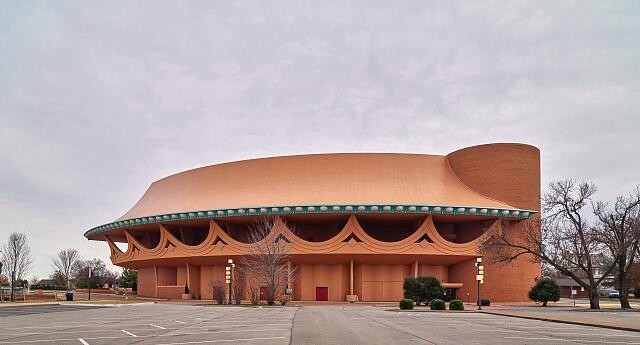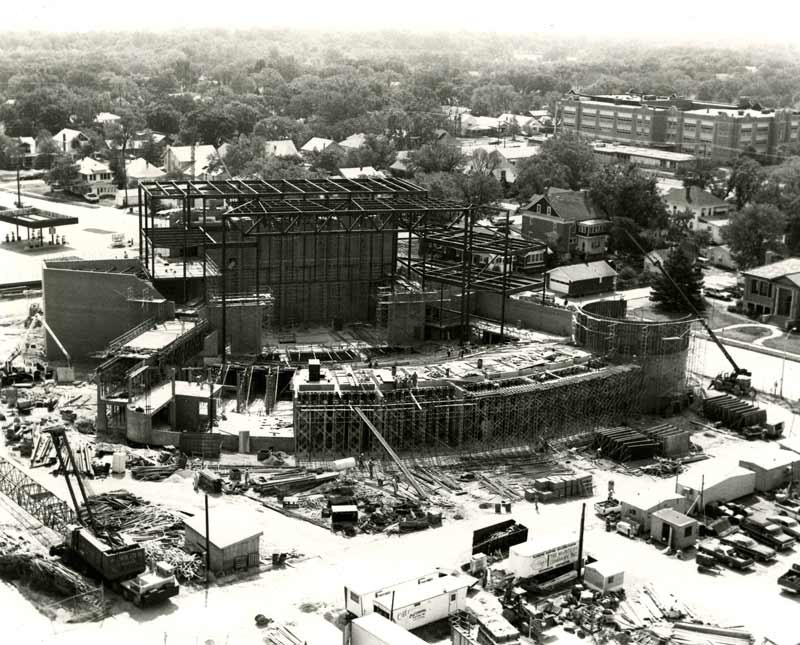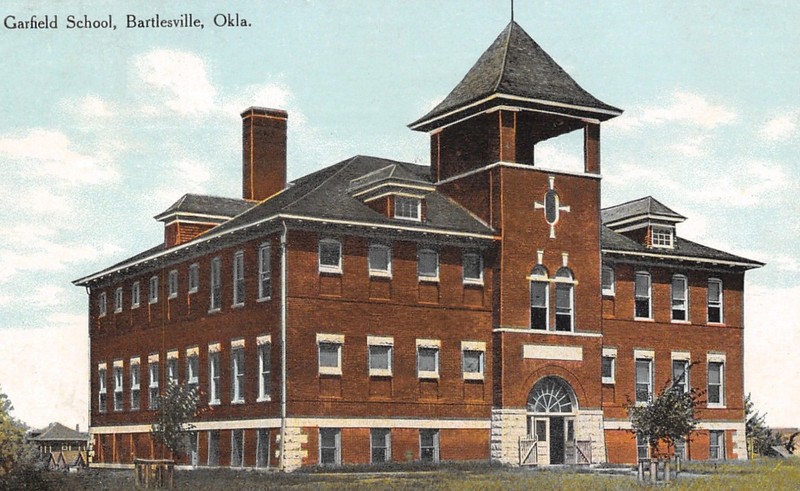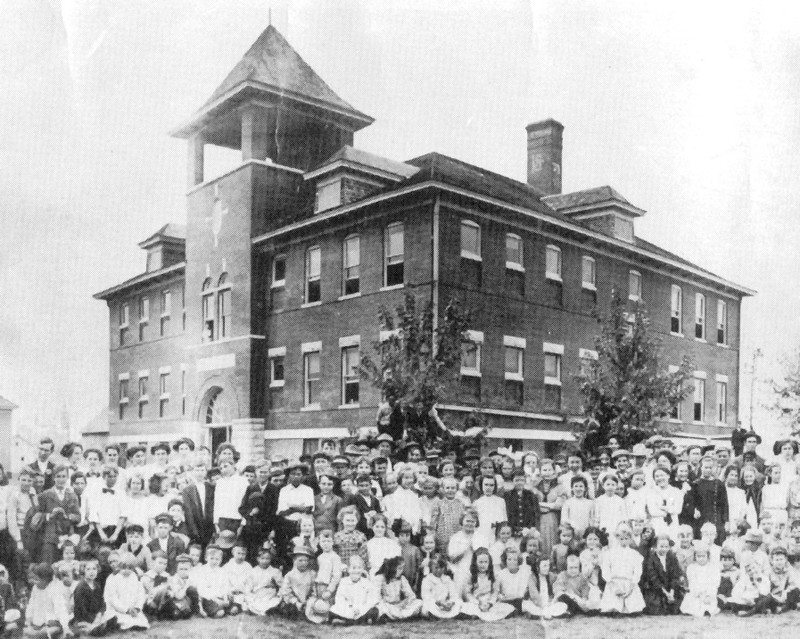Bartlesville Community Center
Introduction
Text-to-speech Audio
Designed by Frank Lloyd Wright protégé William Wesley Peters, the Bartlesville Community Center has become the cultural hub of Bartlesville since its opening in 1982. The center features a curved design and earth-tone color on its outside, while the world’s largest work of cloisonné art and a 1,700-seat concert hall can be found in its interior. Before the Community Center sat at this intersection, it was the home of a two-room log schoolhouse and later Garfield School, Bartlesville’s pioneering permanent grade school. Garfield’s enrollment rose steadily through the early decades of the 1900s matching Bartlesville’s rapid growth before falling off with the city’s outward expansion. Eventually, the school was razed to make way for the now iconic Community Center.
Images
The Bartlesville Community Center was designed by William Wesley Peters, an early student of Frank Lloyd Wright

Construction on the project was started in 1979, with Flintco Inc. selected as the general contractor.

The white stone seen here above Garfield's front door was preserved and now sits at one of Bartlesville's most prominent downtown corners.

Bartlesville's white and Native American students were educated at Garfield, with enrollment reaching 800 children.

Backstory and Context
Text-to-speech Audio
The Garfield Grade School occupied the corner of Sixth Street and Cherokee Avenue long before the Bartlesville Community was constructed. Built in 1904 and opened in 1905, Garfield has the distinction of Bartlesville’s first permanent grade school. The brick building cost $17,230 and housed all grade levels during its first several years. Before Garfield, a two-room wood schoolhouse sat in the same spot and served many children from the area. It was built through community funding as lumber from Jim Stokes’ mill west of Dewey was bought with large donations coming from some of the city’s founders, including William Johnstone, George B. Keeler, Jake Bartles, and Arthur Armstrong.
Garfield was partially funded by a monthly tuition of one dollar per month from white students. Native American students also attended the school, with the Cherokee government paying their teachers’ salaries. African American students were segregated from Garfield, instead attending Douglass School on Bartlesville’s West Side. Eva Mae Kreep and Lillian Emma Evans were Garfield’s first graduating seniors, earning their diplomas on May 5, 1907.
Matching Bartlesville’s boomtown reputation, classes at Garfield grew from 469 to 800 students. Eventually, in 1910, high schoolers began attending the newly built Bartlesville High School, and seven years later, students above sixth grade shifted to Central School, the first junior high school in Oklahoma. Although fewer grades were offered at Garfield, the school continued to grow. Seven classrooms and an assembly hall were added to the school’s footprint in 1929, costing $64,000 to build. As the century went on, enrollment at Garfield decreased, and eventually, the school closed in 1974. It was torn down in the late 1970s to make way for the new community center. However, the light-colored stone that once sat above the school’s doorway and reads “19 Garfield School 04” was preserved and placed at the intersection of Dewey Avenue and Adams Boulevard, commemorating the long-lasting impact of Garfield in the community.
Construction started on the Bartlesville Community Center in 1979 and was completed three years later. The design was created by William Wesley Peters, a protégé and early student of Frank Lloyd Wright. Peters was the chief architect at Tallesin Associated Architects, a part of the Frank Lloyd Wright Foundation, and its fitting that the center sits only a short walk away from the Price Tower, Wright’s only skyscraper. The Community Center is accentuated with sweeping curves, ovals, and obtuse angles, and its exterior earth tone colors are match inside the building. The interior also contains the world’s largest cloisonné artwork, an ancient method of metalwork that decorates unique metal strips with colored material. The piece is a 25-foot-long mural depicting an idyllic Oklahoma countryside. The 94,000 square foot facility was funded through private and corporate donations, as well as a sales tax, and the entire $13 million bill was paid before its opening in 1982.
The center’s hub is a 1,700-seat theater, which welcomed Hal Holbrook playing Mark Twain in his famous one-man show as its first touring act. Since then, the facility has hosted numerous concerts and Broadway shows. Most notably, the Community Center acts as the heart of the OK Mozart International Festival, held annually in Bartlesville since 1985. The festival is kicked off every June and celebrates the classical Austrian composer Wolfgang Amadeus Mozart. The celebration was the creation of conductor Ransom Wilson, who characterizes the community center as “one of the finest concert halls in this country.”
Sources
Garfield, Bartlesville Public Schools. Accessed May 1st 2022. https://bartlesvillepsok.sites.thrillshare.com/page/garfield.
History of the BCC, Bartlesville Community Center. Accessed May 1st 2022. https://www.bartlesvillecommunitycenter.com/bcc-history.
May, Jon D.. OK Mozart International Festival, The Encyclopedia of Oklahoma History and Culture. Accessed May 1st 2022. https://www.okhistory.org/publications/enc/entry.php?entry=OK096.
Carol Highsmith - Library of Congress
Bartlesville Community Center
Bartlesville Public Schools
Bartlesville Public Schools
